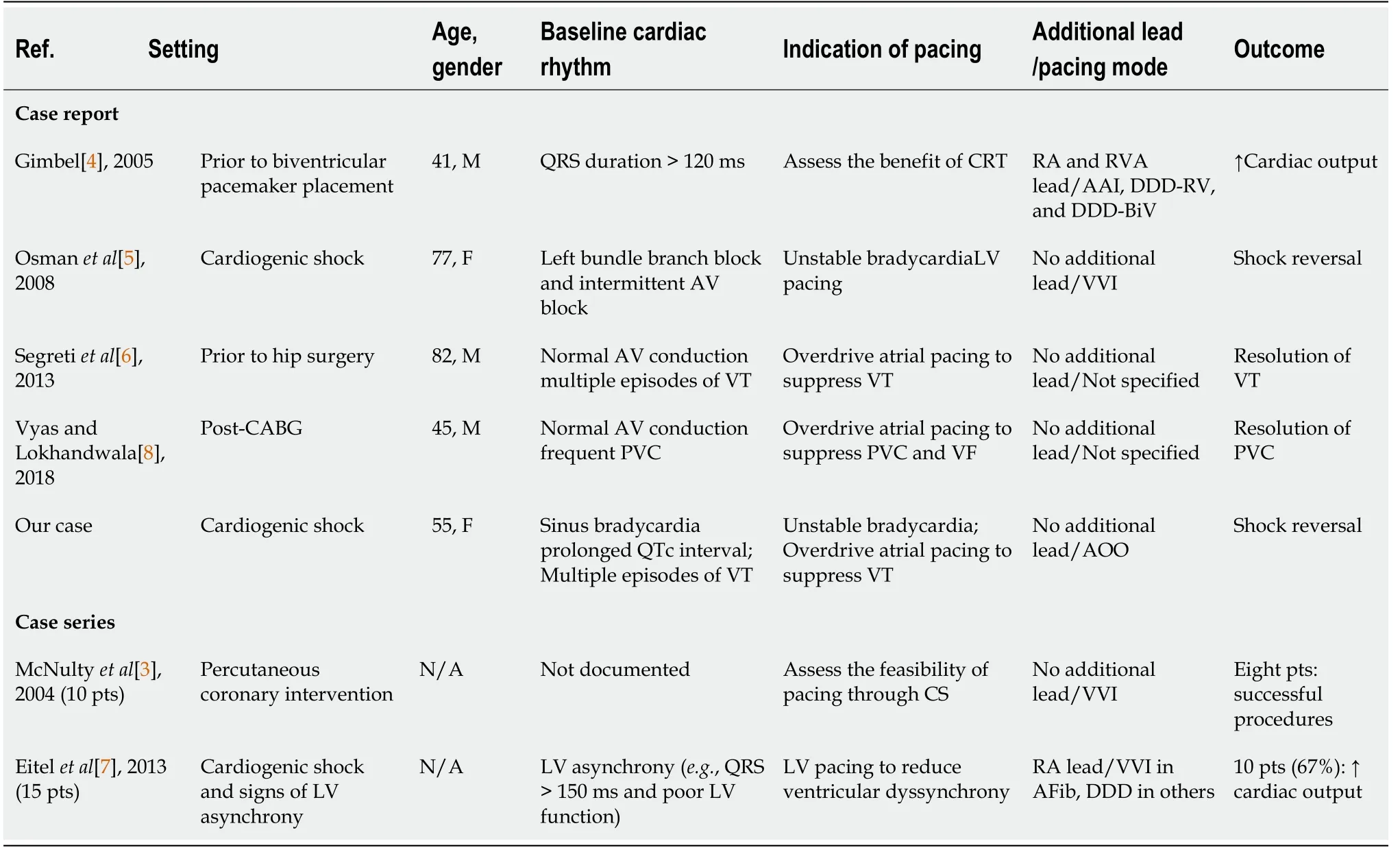Temporary coronary sinus pacing to improve ventricular dyssynchrony with cardiogenic shock: A case report
Teressa Reanne Ju, Hsin Tseng, Hsin-Ti Lin, Alexander Lee Wang, Chi Chan Lee, Yi-Ching Lai
Teressa Reanne Ju, Department of Internal Medicine, NewYork-Presbyterian Queens Hospital,Queens, NY 11355, United States
Hsin Tseng, Hsin-Ti Lin, Alexander Lee Wang, School of Medicine, China Medical University,Taichung City 40447, Taiwan
Chi Chan Lee, Department of Critical Care Medicine, Guam Regional Medical City, Dededo 96929, Guam
Yi-Ching Lai, Department of Cardiology, Division of Internal Medicine, China Medical University Hospital, Taichung City 40447, Taiwan
Abstract BACKGROUND Temporary transvenous pacing through the coronary sinus is a novel approach rarely used in treating unstable bradycardia. This modality could provide cardiac pacing while achieving better ventricular synchrony. We present a case who received cardiac pacing through the coronary sinus and provide a summary of evidence in the current literature.CASE SUMMARY A 55-year-old woman with a history of advanced heart failure was admitted to the rehabilitation ward after a recent stroke. During hospitalization, she had paroxysmal atrial fibrillation with rapid ventricular response resulting from fluid overload. While atrial fibrillation was spontaneously reversed to sinus rhythm after diuresis, she developed multiple episodes of polymorphic ventricular tachycardia along with sinus bradycardia and prolonged QTc interval. She became hypotensive despite appropriate medical management. Pacing through her implantable cardioverter-defibrillator was attempted but worsened her hypotension. Ventricular dyssynchrony was suspected. Temporary transvenous atrial pacing through the coronary sinus was performed, which stabilized her blood pressure and improved end-organ perfusion. A permanent biventricular pacemaker was later implanted, and she was safely discharged to a nursing home.CONCLUSION Temporary transvenous pacing through the coronary sinus, a novel approach to treat unstable bradycardia, may reduce ventricular dyssynchrony.
Key Words: Cardiac resynchronization; Artificial pacemaker; Coronary sinus; Heart failure; Cardiogenic shock; Case report
INTRODUCTION
Placement of a temporary pacing wire (TPW) to the right ventricle apex (RVA) and implementing single chamber pacing are the most common approaches to treat unstable bradycardia[1]. In the presence of severe left ventricular (LV) dysfunction,this modality may worsen ventricular dyssynchrony and impede hemodynamic profiles[2]. While being a more complex procedure, placement of TPW to the coronary sinus (CS) could make atrial or LV pacing possible which results in better ventricular synchrony. Cardiac pacing through the CS has rarely been reported in different clinical settings[3-8]. We herein present a unique case of applying temporary atrial pacing through the CS in a patient who had unstable bradycardia complicating cardiogenic shock. In addition, we provide a review of literature of this novel approach.
CASE PRESENTATION
Chief complaints
A 55-year-old woman was transferred to our medical ward due to dizziness for 48 h.
History of present illness
The patient was initially admitted to our rehabilitation ward after a large middle cerebral artery infarction and was transferred to our medical ward due to atrial fibrillation with a rapid ventricular rate due to fluid overload. Diuretics and low-dose beta blockers were administered. Her heart rhythm was spontaneously reversed to sinus rhythm for a short period of time. However, she started to have frequent polymorphic ventricular tachycardia (VT) resulting in cardiogenic shock. Despite receiving high doses of antiarrhythmic agents such as amiodarone, lidocaine, and multiple attempts of defibrillation, she still experienced multiple episodes of VT, along with sinus bradycardia and prolonged QTc interval of 516 milliseconds (Figure 1).

Figure 1 Electrocardiogram (prior to pacing wire placement): Sinus bradycardia and prolonged QTc interval of 516 milliseconds.
History of past illness
The patient had a history of non-ischemic cardiomyopathy with baseline ejection fraction of 15% with implantable cardioverter-defibrillator (ICD) placement and paroxysmal atrial fibrillation.
Personal and family history
The patient's personal and family history were unremarkable.
Physical examination
Physical examination was notable for blood pressure of 87/50 mmHg, heart rate of 52 beats/min, cold extremities, rales over bilateral lung fields on auscultation, and confusion on neurological exam. She was afebrile and had no focal neurologic deficits.
Laboratory examinations
Serial troponin I levels (< 0.03 mg/mL) were within the normal range. Her hemoglobin level was stable at 9.5 g/L. Biochemistry panels were notable for hyponatremia (125 mmol/L) and mild hypokalemia (3.2 mmol/L). Her B-type natriuretic peptide was 18388 pg/mL.
Imaging examinations
Electrocardiogram (ECG) revealed multiple VT episodes, along with sinus bradycardia and prolonged QTc interval of 516 milliseconds (Figure 1).
FINAL DIAGNOSIS
The final diagnosis was polymorphic VT and unstable bradycardia complicating cardiogenic shock.
TREATMENT
Dobutamine infusions at 7.5 μg/kg/min were started to treat cardiogenic shock.Cardiac catheterization was not conducted because of her unremarkable troponin levels and a normal coronary angiogram performed a month ago. The patient was deemed not a candidate for heart transplant or a left ventricle assisted device due to her poor functionality caused by her recent stroke. With regard to her unstable sinus bradycardia, we applied single chamber pacing through her ICD which adversely aggravated her hypotension. A ventricular dyssynchrony was suspected. To achieve cardiac resynchronization, we placed a TPW to the CSviaright femoral vein cannulation under fluoroscopy guidance (Figure 2). The procedure was smooth and without any complications. Atrial pacing at 80 beats/min with an AOO mode was initiated (Figure 3).

Figure 2 Cardiac catheterization: Placement of temporary pacing wire to the coronary sinus.

Figure 3 Electrocardiogram (after pacing wire placement): Atrial pacing with an AOO mode.
OUTCOME AND FOLLOW-UP
The patient’s hemodynamic profiles improved significantly after the procedure.Dobutamine infusions were weaned off within a day following the procedure. She received permanent biventricular pacemaker implantation 3 d later and survived throughout hospitalization.
DISCUSSION
Temporary transvenous pacing has become the mainstay of treatment for patients who have unstable bradycardia[1]. In terms of electrode lead placement, the RVA is the preferred site given its easy accessibility and long-term stability of lead position and stimulation threshold[9]. While cardiac pacing through the RVA is generally welltolerated in the short term, this approach could immediately worsen hemodynamic profiles in patients who are at risk of ventricular dyssynchrony[7]. A growing body of evidence has also shown that pacing through the RVA could lead to dyssynchronous LV electrical activation and remodeling of the myocardium, resulting in higher mortality in the long term[2,10]. Certain conditions may limit the use of cardiac pacing through the RVA. For example, failure to capture on pacemaker can occur in patients who have RV ischemia[9]. Stability of lead position would be challenging in patients who have significant tricuspid valve disease[11].
CS as an alternative temporary pacing site was previously studied as shown in the literature, primarily for the purpose of overdrive atrial pacing to suppress ventricular arrhythmia or LV pacing to reduce ventricular dyssynchrony (Table 1). In 2004,McNultyet al[3] first reported a case series of 10 patients who received temporary LV pacing through the CS while undergoing percutaneous coronary interventions involving the right coronary artery. Procedures were successful in eight cases, while one case had failure to capture on pacemaker and one case had difficulty in CS cannulation. No complications were noted, and the average procedure time was 3.8 min. Gimbel[4] then used the CS as the pacing site to assess the need of cardiac resynchronization therapy prior to biventricular pacemaker placement. In 2008,Osmanet al[5] reported accidental placement of TPW at the CS in a heart failure patient with cardiogenic shock and complete AV block. Unexpectedly, the patient’s shock status significantly improved. Eitelet al[7] further evaluated the feasibility of temporary transvenous LV pacing through the CS in 15 patients who had refractory cardiogenic shock and asynchronous LV function. Among them, 10 patients (67%)acutely responded by improvement of hemodynamic parameters and no complications were noted. Two cases[6,8] where the CS was used as the pacing site to achieve overdrive atrial pacing and suppress ventricular arrhythmia were reported. Both cases succeeded without further complication.

Table 1 Summary of case reports or case series of temporary transvenous pacing through the coronary sinus
Pitfalls exist when it comes to applying temporary transvenous pacing through the CS. First, while placement of electrode catheters to the RVA can be performed in several ways, such as blind techniques, intracavitary ECGs or echocardiograms[1],placement of electrode catheters to the CS always requires fluoroscopy guidance. This requirement limits its use in patients with hemodynamic instability. Second, CS catheterization is not an innocuous procedure. A retrospective study of 62 patients who had CS catheterization during cardiac surgery showed that 6% of patients had blood in the pericardial space and 4.8% of patients had small bleeding spots in the RV wall following the procedure[12]. Consequently, CS catheterization should be performed by operators who can recognize and troubleshoot those complications. Lastly,difficulty in catheterization due to unsatisfactory CS anatomy occurs at times. Backup plans are needed if temporary pacing through the CS turns out to be unsuccessful.
CONCLUSION
Temporary transvenous pacing through the CS is a novel approach to treat unstable bradycardia. Compared to pacing through the RVA, pacing through the CS may induce a more physiologic ventricular depolarization and reduce ventricular asynchrony. This modality has been studied in patients who required overdrive atrial pacing or had unstable bradycardia and evidence of ventricular dyssynchrony.Technical requirements, potential complications and backup plans should be addressed prior to the procedure. Further prospective studies are warranted to establish the clinical benefits of this approach.
 World Journal of Clinical Cases2021年20期
World Journal of Clinical Cases2021年20期
- World Journal of Clinical Cases的其它文章
- Obesity in people with diabetes in COVID-19 times: Important considerations and precautions to be taken
- Revisiting delayed appendectomy in patients with acute appendicitis
- Detection of short stature homeobox 2 and RAS-associated domain family 1 subtype A DNA methylation in interventional pulmonology
- Borderline resectable pancreatic cancer and vascular resections in the era of neoadjuvant therapy
- Esophageal manifestation in patients with scleroderma
- Exploration of transmission chain and prevention of the recurrence of coronavirus disease 2019 in Heilongjiang Province due to inhospital transmission
